It was the ‘Kane-Son’ duet that done the damage at St. Mary’s this past weekend. The English Captain laid on the South Korean for four of Tottenham’s five goals against the Saints, while Harry Kane claimed his sides fifth and final goal in this seven-goal affair.
Danny Ings netted both the first and final goal of the game, first finishing low from a wide-angle inside the box on 32 minutes, and then again converting a penalty down the middle on 94 minutes.
The final score was Southampton 2 – 5 Tottenham Hotspur. However, it is worth noting the North London side exceeded their xG for this game by +3 goals, as the data had an xG rating of 2.51 to 2.00 respectively in favour of the hosts.
Our tactical analysis below delves into the tactics and key talking points of both sides. Here our analysis looks at how both Ralph Hasenhüttl and José Mourinho set their sides up to get success while nullifying the opposition’s threat in the process.
Lineups
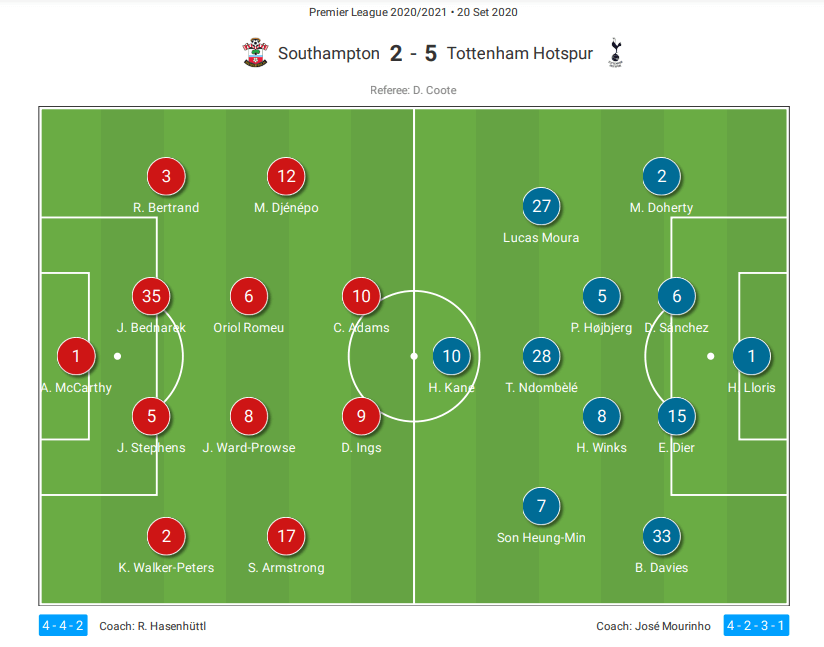
Southampton: 4-4-2
The tried and trusted Alex McCarthy started between the posts while in front, the back four arguably made up Southampton’s best defence. The right-footed Moussa Djénépo bolstered his teams attack as an inverted winger on the left while Scottish international Stuart Armstrong inverted from the right-wing on his natural side.
James Ward-Prowse and Oriol Romeu commanded the centre while Danny Ings and Che Adams played as a ‘9’ and ’10’ respectively. Adams often coming short in the build-up to receive long forward passes while dragging defenders from the Tottenham backline.
Tottenham Hotspur: 4-2-3-1
The Captain and World Cup winner Hugo Lloris starts as the last line of defence for his team in goal while new signing Matt Doherty starts at right-back alongside the experienced Davinson Sánchez and Eric Dier.
Another Summer arrival starts in central midfield, Pierre-Emile Højbjerg plays one half of a double-pivot beside Harry Winks. While just up ahead Tanguy Ndombèlé, Harry Kane, Lucas Moura and Son Heung-Min make up the pacey front line for the men in white.
Spurs penetrate from the middle third
In attack, Spurs morphed into a 4-3-3, with Son, Kane and Moura playing as a narrow front three on the shoulder of the last defender with two holding and one attacking midfielder just behind. Out of possession Spurs formed a compact block in a 4-5-1, so naturally, the shape balances out in a 4-2-3-1.
Spurs relentlessly looked to penetrate from the middle third if not deep in their own half at times. In the build-up, the Spurs back four and two holding midfielders would play deep to invite Southampton players to high-press.
This served to make Southampton commit their midfielders and full-backs into Spurs third of the field. At this point, Spurs would utilise their overload well from deep to discover and play penetrating passes centrally over the high line of the opposition.
Once in flight, the well-timed ‘out-to-in’ angled runs of Son and Moura would meet the first bounce of the ball over the Saints backline. Although historically this long direct method has proven relatively ineffective, it was the synchronised pass to run relationship combined with the blistering pace of the South Korean and the Brazilian that made this work.
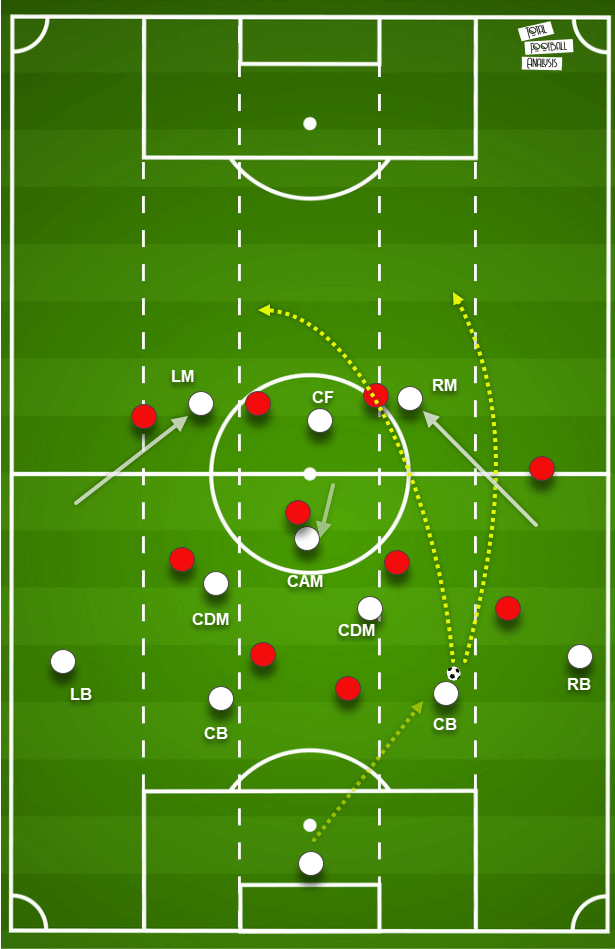
Above we see a tactical annotation of Spurs movement in the build-up phase. As one centre-back was in possession deep in the half-space, he would immediately look for the movement of the wide forwards relative to the position of the Saints defence before playing a long, penetrating pass forward.
Also notice how flat the back four are in the build-up, as Ben Davies and Matt Doherty, both full-backs played deep to invite the Southampton full-backs higher up the field. This also served to create space in the channels for Moura and Son to run into unmarked.
The three images below capture Tottenham’s principles of play adequately; at this moment, Spurs also scored their third goal.
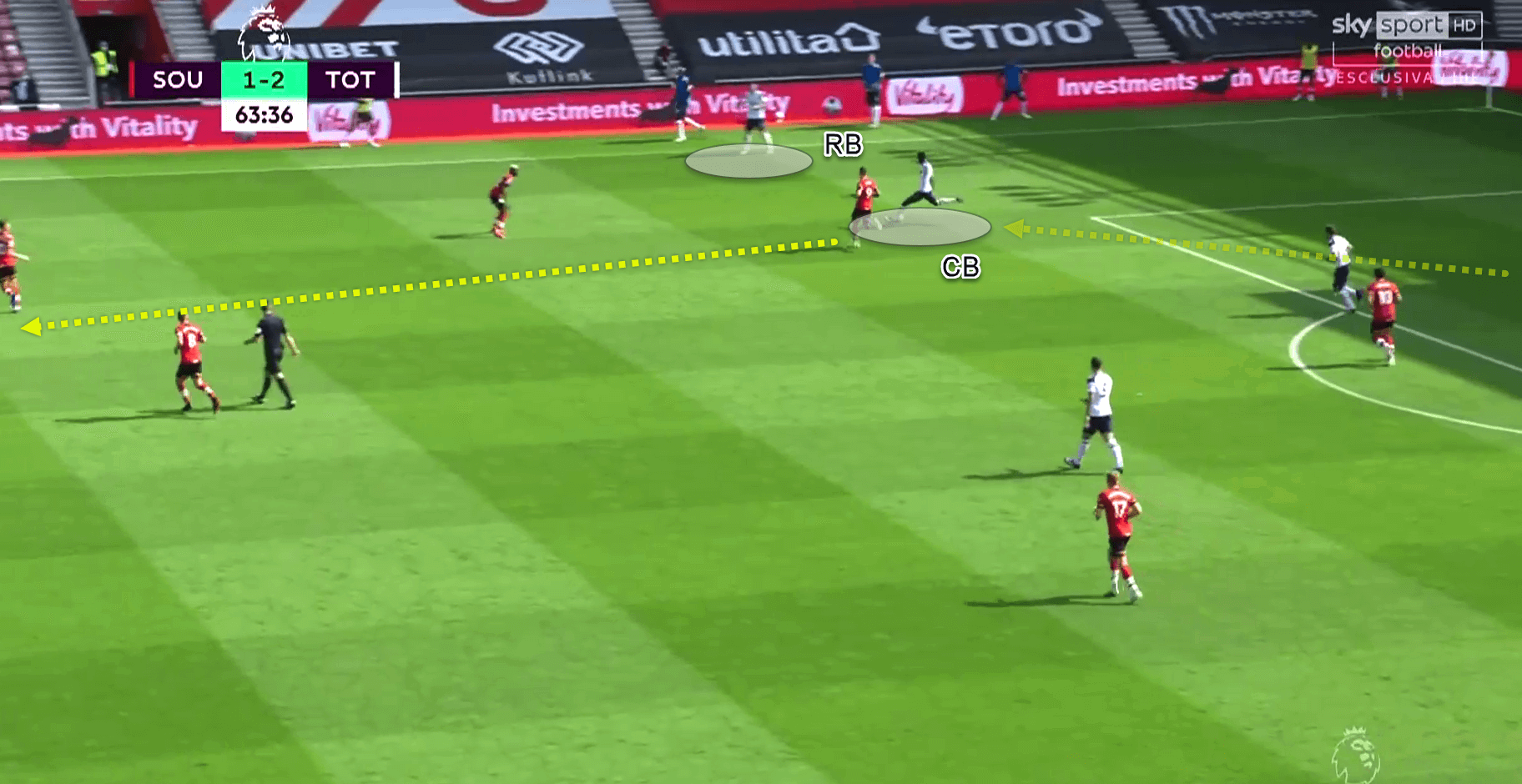
Above, we see Sanchez plays a long pass forward to the striker Harry Kane before he is challenged by the Saints frontman. Also, observe the Right-back Doherty’s position here, notice how deep and close he is to his teammate, as he helps to create overloads from deep and invite the Southampton press.
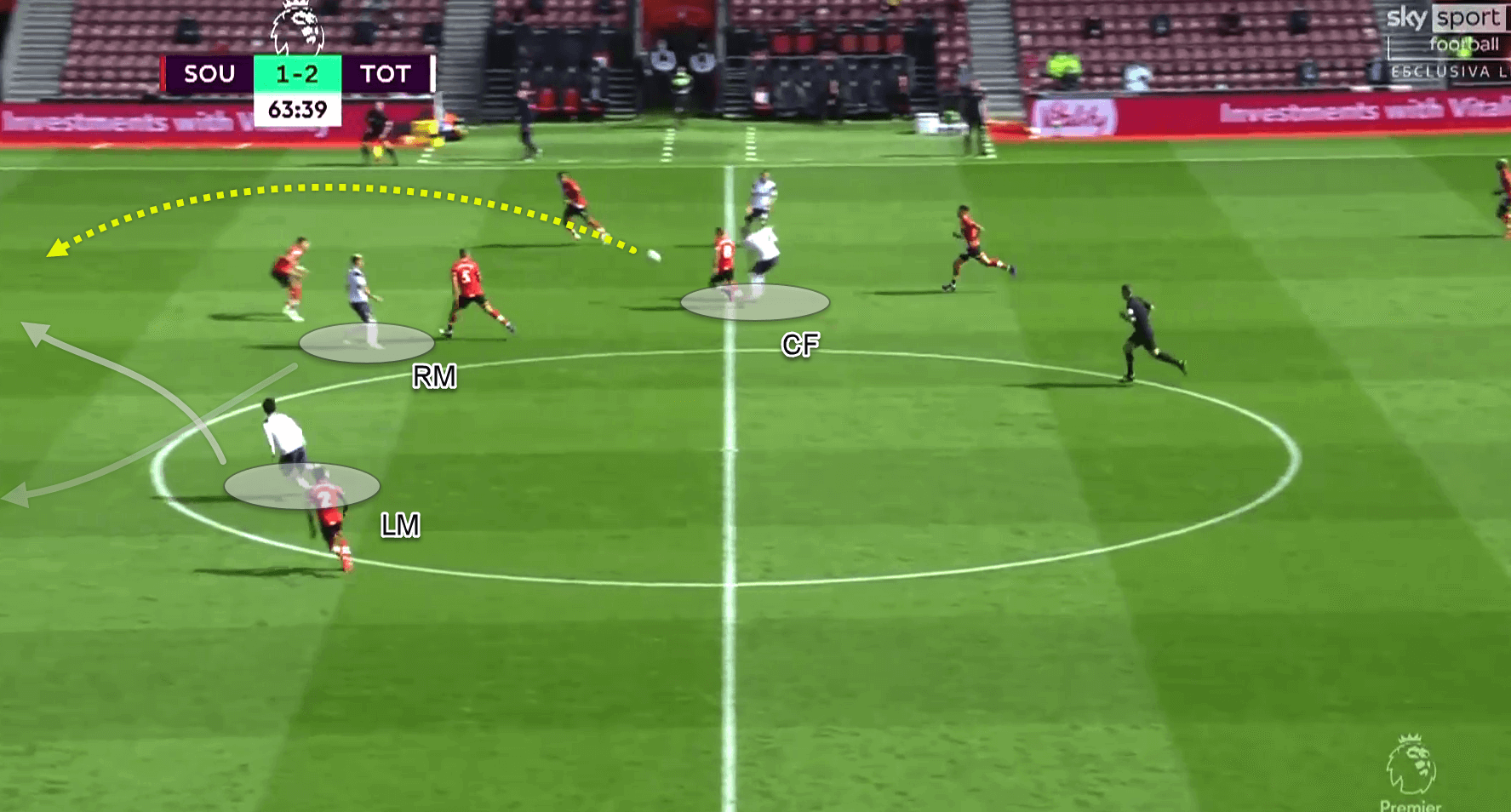
In the next image, we see Kane, controls well, turns early and creates an angle to play another forward pass into the half-space. In doing so Son and Lamela (the substitute of Moura later in the game) make a crossover movement to adequately beat the offside trap and secondly to lose their defender.
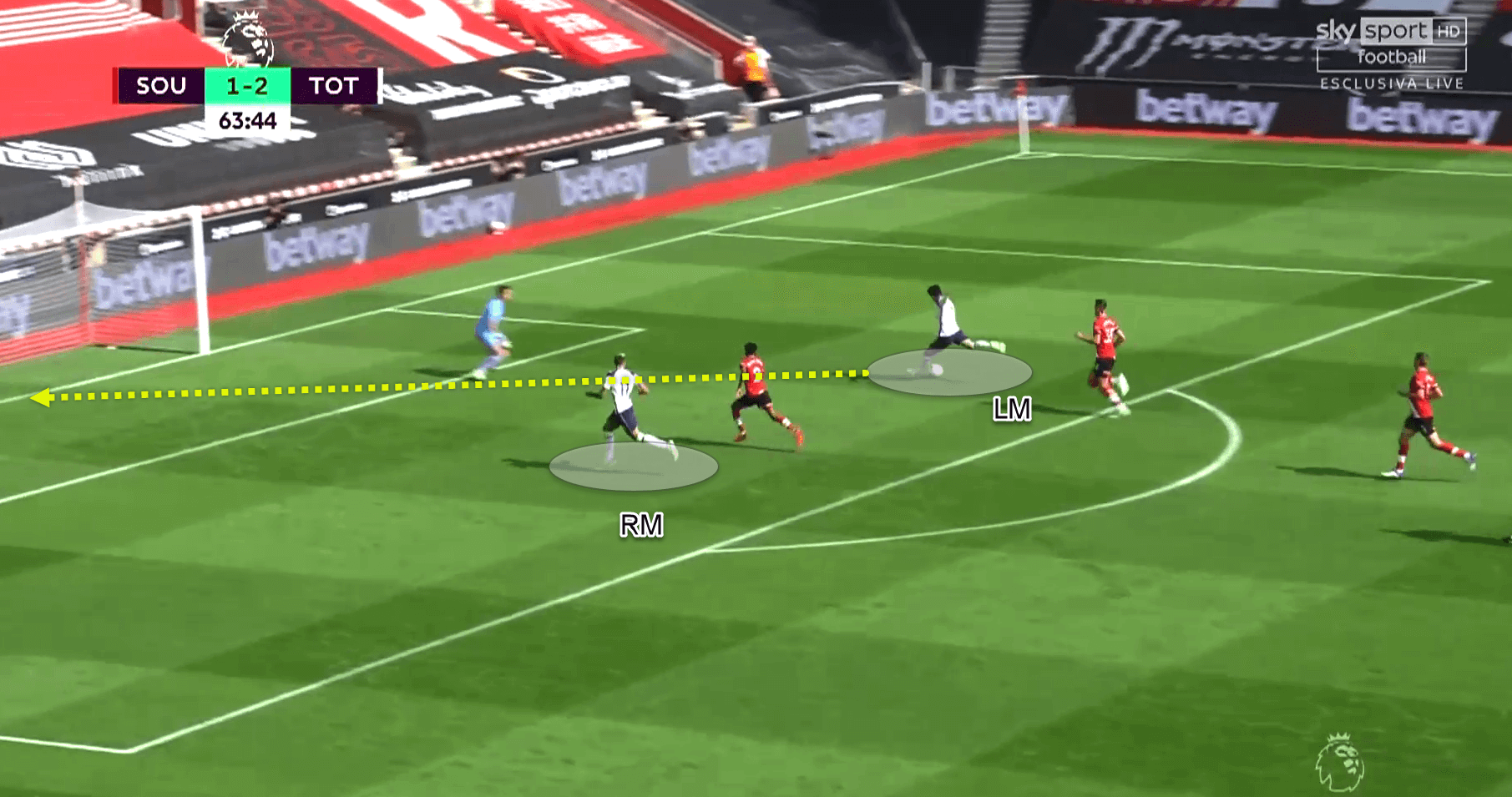
Son meets the forward pass on his run, and with only three touches, he converts down low to the goalkeepers right. Notice Lamela also arrives in an excellent position to either receive a pass or attack any loose balls that might have been saved.
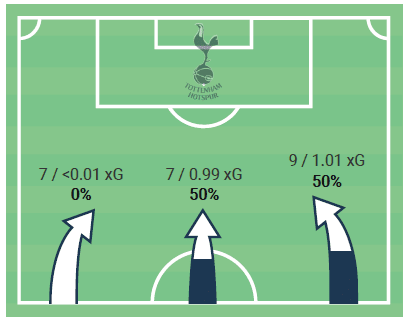
The data above shows us Spurs’ Attacks by Flanks’, here we can see the attacks were quite evenly balanced across all three zones with greater xG coming from the centre-and the right.
Considering Southampton amounted an average PPDA of 6.8 in contrast to Tottenham’s 17.3 and with Spurs claiming on 43% game average of possession the data also suggests the visitors deliberately opted for a more direct route to goal than a low-risk low-reward build-up.
Saints slack in the press
One would have to imagine the lack of intensity and efficiency will be a crucial talking point among the Southampton staff and players when they review their performance. For all the labour and energy applied in the high-press Southampton caused themselves more problems not competing well enough and reacting to the triggers in Spurs build-up.
The below three images captures but one of many moments in the game Spurs played through the Southampton press.
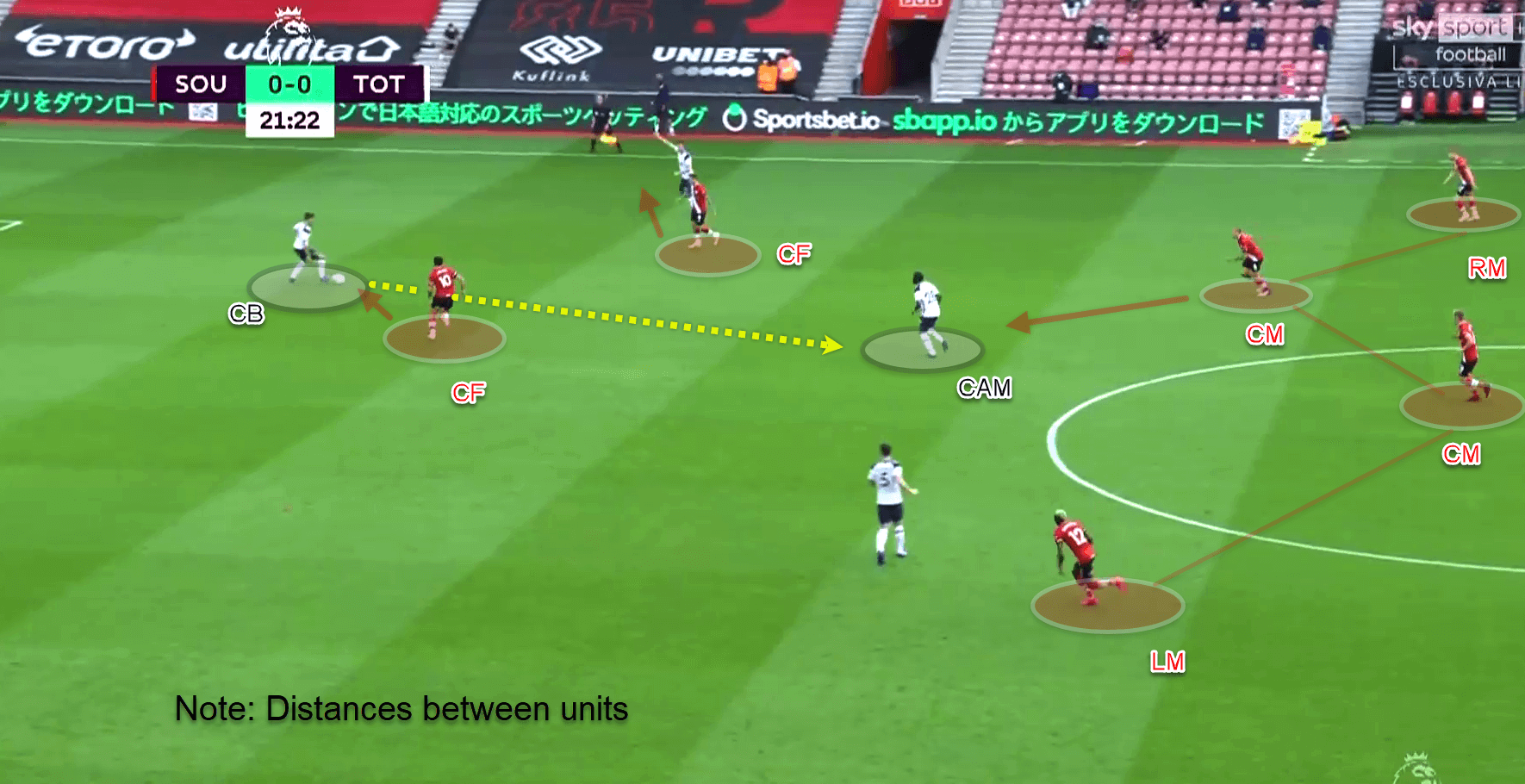
Above, we see the Spurs centre-back is in possession, Danny Ings steps forward to engage the press on the ball carrier, as he does, his teammates in midfield are slower to react and as a result, leave time and space for the CAM for Spurs to receive a pass and turn.
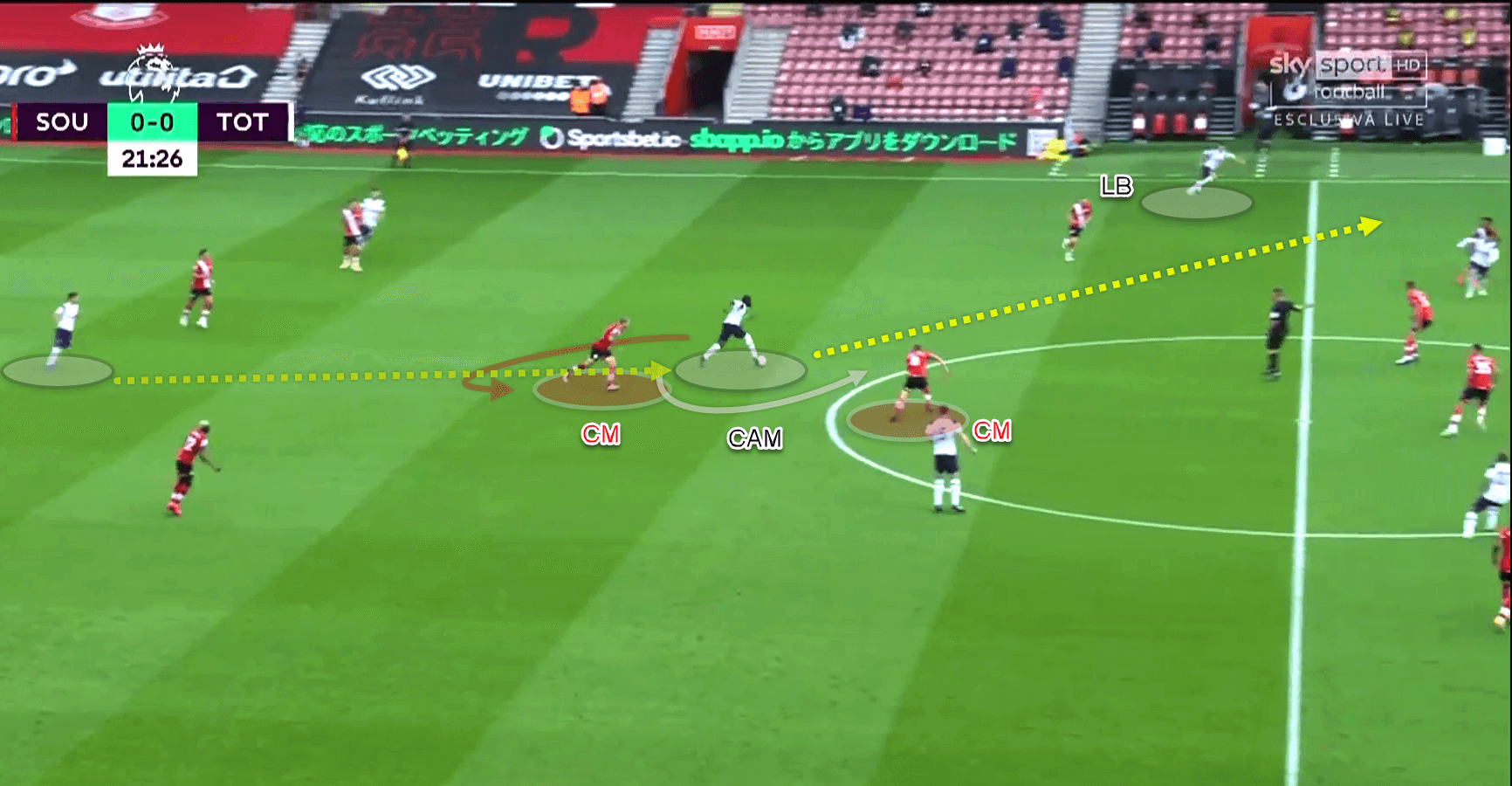
The Spurs midfielder turns and evades the late challenge from the Southampton midfielder. With minimal touches, Ndombèlé plays a pass forward out to the left-back advancing on the wing.
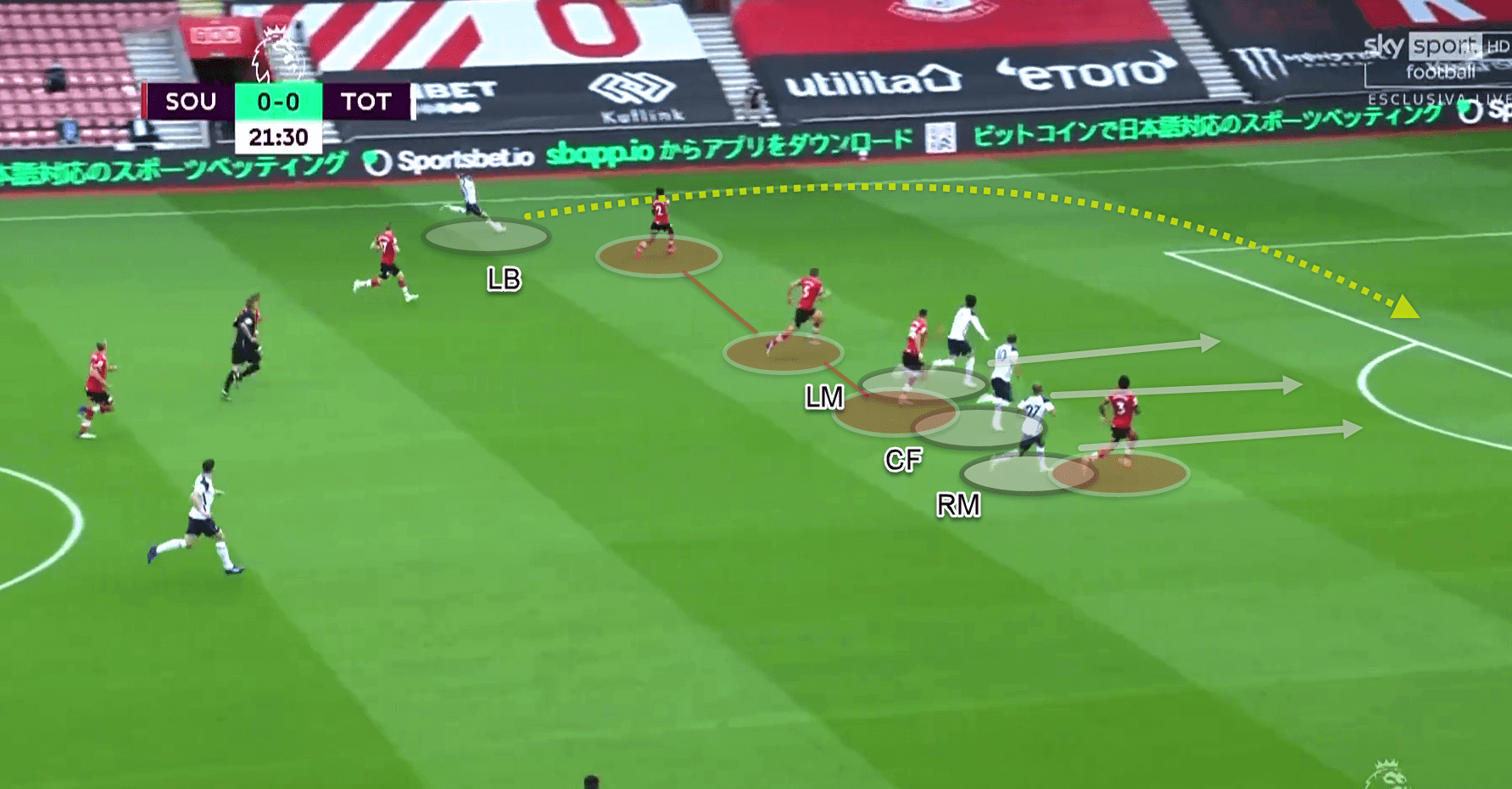
Moments later the Southampton defenders are in a footrace back to their goal in contest with the narrow and dangerous front three of Tottenham. Another reason why this is dangerous is the Spurs full-back has ample time and space to measure and deliver a cross.
Two critical factors that resulted in Southampton’s demise as the game progressed: an ineffective pressing strategy and a lack of aggression in transitions.
The Saints will need to improve in this area as they meet more of the Premier Leagues top sides going forward. Nothing but perfection and aggression in a systematic press will be required as they play some of England’s best.
Tottenham triumph in the transitions
As the xG suggested, perhaps Southampton might have run out worthy winners but where the game was actually won and lost was in the transitions. Owing perhaps to his tactical genius and vast experience at the highest level, Mourinho’s side seemed far superior in both the transition to defend and attack.
The famed dark arts were on show from the men in white, cutting down the proficient ball carriers in red in the transition to defence. Committing 18 fouls mostly in the transition and before the Saints reached the final third, Spurs were deliberate and intelligent in stopping the attacks before they could be considered dangerous.
In attack, Spurs were even more enthusiastic and deliberate to play forward early and utilise the quick and technically proficient ball carriers to drive at the Saints backline as well as attacking the pocket of space with good forward passing combinations.
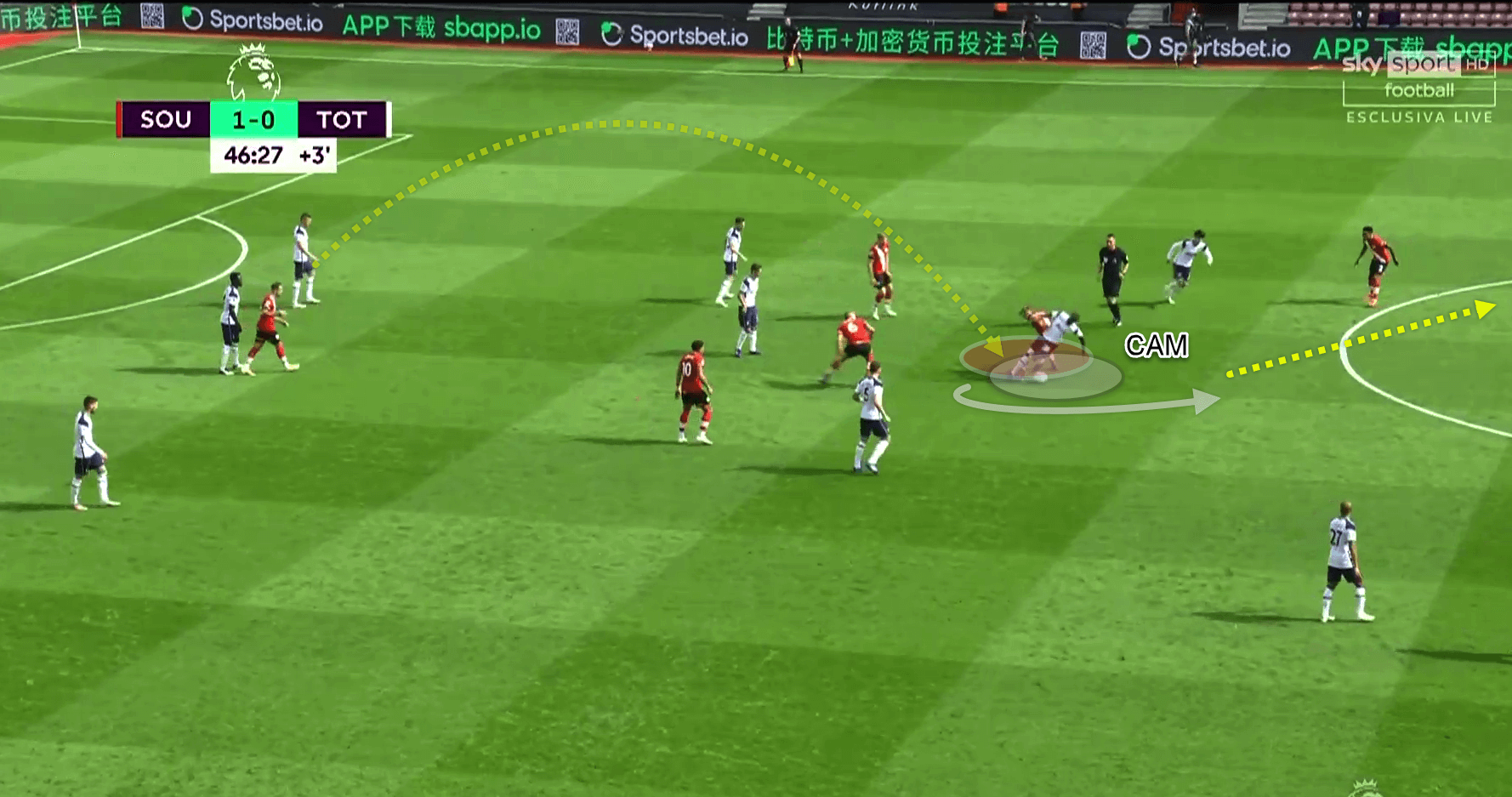
Above we see the first touch of a Spurs player as they transition to attack. Ndombèlé is aggressive, understanding the value in winning the physical contest to turn and play forward early. He does so successfully and picks out Harry Kane with a forward pass on the left.
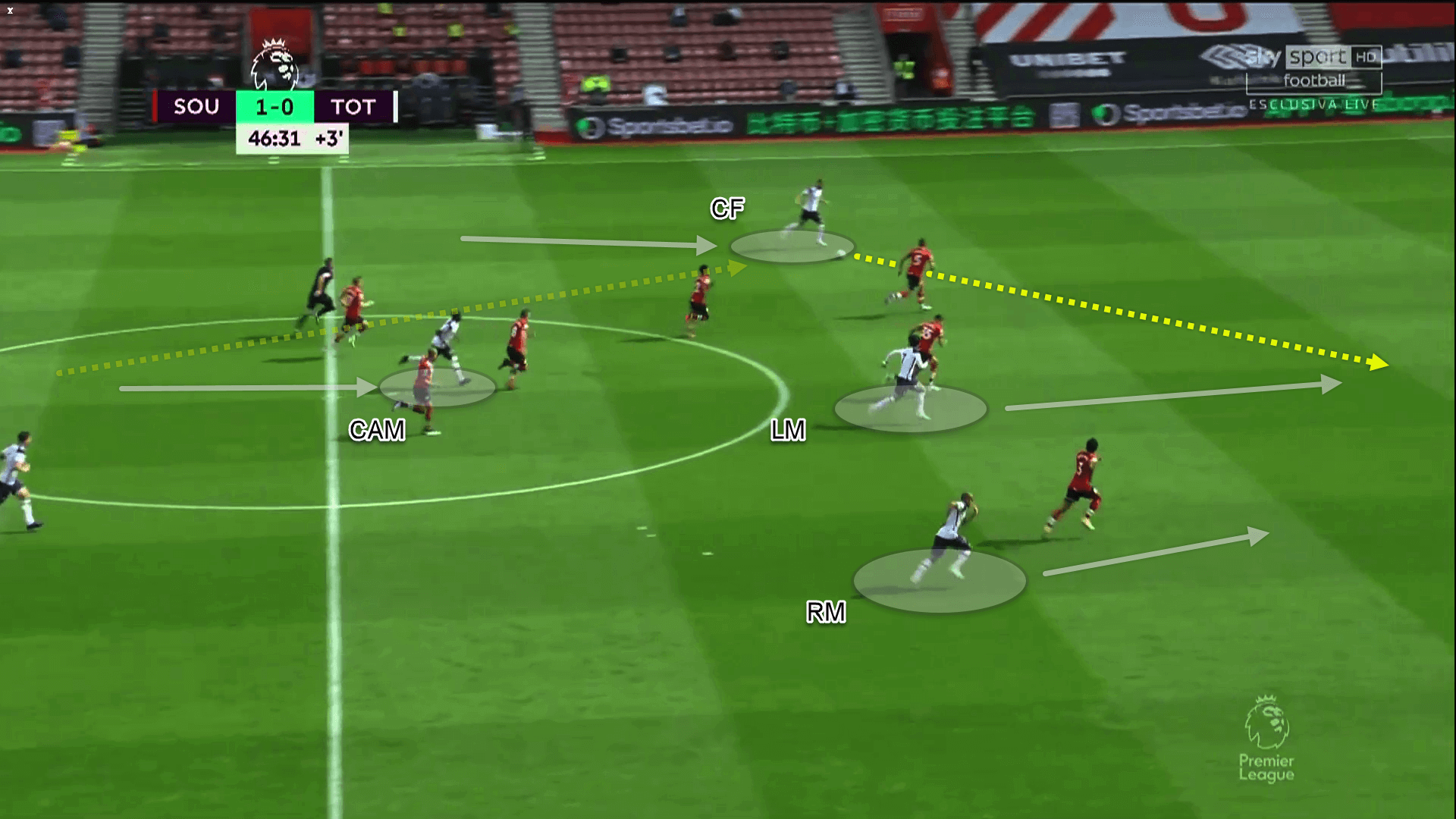
Kane only needs two touches to feed a ball into the run of Son; Spurs get their opener at this moment. The assist and finish have rightly been admired; however, it is Ndombèlé’s aggression to start the attack that deserves the plaudits.
Saints same attacking principles
For the entirety of the game, Hasenhüttl stuck to his 4-4-2 shape and same patient build-up attacking principles. An argument can be made that a change in approach might have served them better as Spurs proved difficult to break down.
One consideration might be, being a little more direct from deep like Spurs and utilising the speed of Djénépo and Armstrong to drive at disorganised Spurs defence when the opportunity presented itself. Nonetheless, had the result played out as the xG model predicted then Southampton would not need to make other considerations.
Southampton looked to build-up through the thirds, the full-backs were integral to this as they would be present in every third of the field to create overloads and also be key players to advance the attacks in wide areas.
As the Saints progress into the opponents half in possession, then movements happen to help progress the attack and unlock the opponents final third. The wide midfielders drift into the half-space to create overloads. Here they can receive passes and play forward or create space for teammates by occupying an opposition midfielder.
The ’10’ Adams, would also make quick, well-timed runs to receive a pass unmarked, where he would look to turn immediately to serve forward passes to the more advanced players, such the the ‘9’ Ings or the wide midfielders.
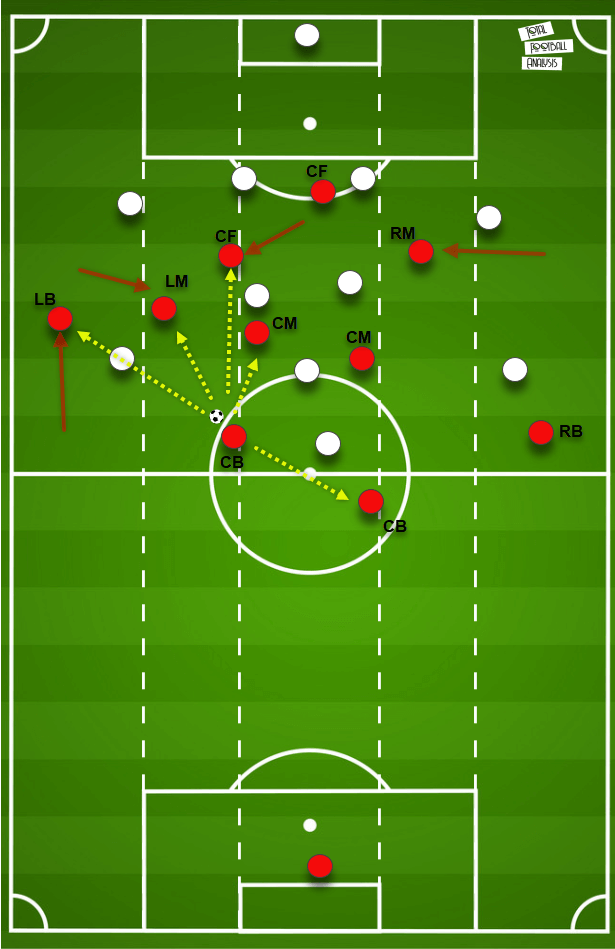
Above we see a tactical annotation of a common picture in the Saints build up. Notably, as Spurs occupied a mid-block, this allowed Southampton to have shorter passing distances between the units.
Notice how both wide midfielders drift inside while Adams the ‘CF’ comes short to be a vertical passing option for the nearside centre-back.
From this position, The men in red have multiple options to progress or retain possession.
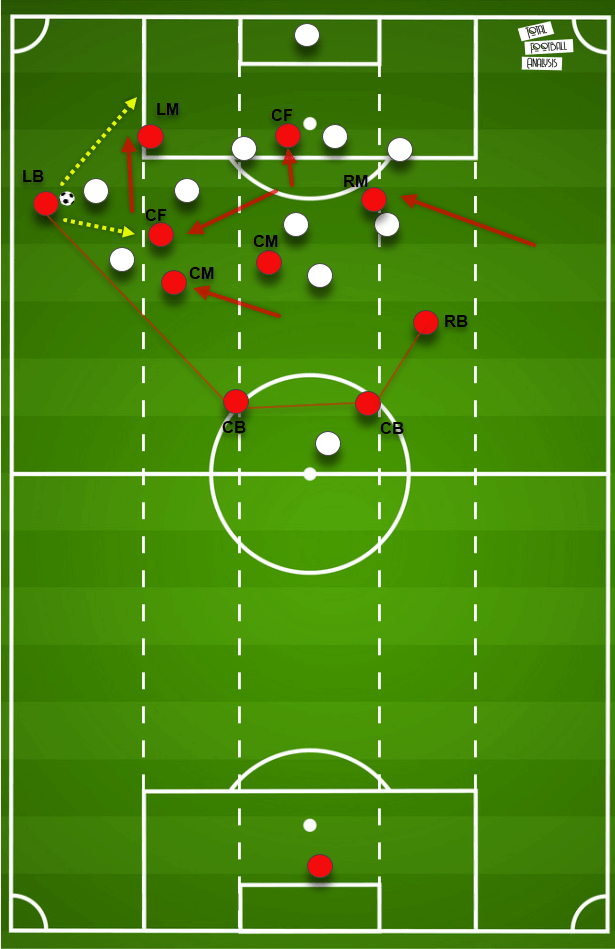
When the Saints attack would reach the wide areas of the Spurs final third, key movements would repeat throughout the game, as the left-back Ryan Bertrand would be able to provide left-footed crosses he would hold the widest position. At the same time, Djénépo would make penetrating runs in the half-space to gain entry into the box, in possession, on his dangerous right foot.
Meanwhile, the wide midfielder on the opposite side would tuck in and offer more numbers centrally to unbalance the defence as the ’10’ Adams would also come across to help create passing combinations to unlock the defence.
Below are four images, a continuous moment which captures Southampton’s attacking principles and individual flair in the final third.

Above, the Saints centre-back Jack Stephens receives a pass from the goalkeeper, before Kane engages the press he creates an angle to play a pass forward to the right-back.
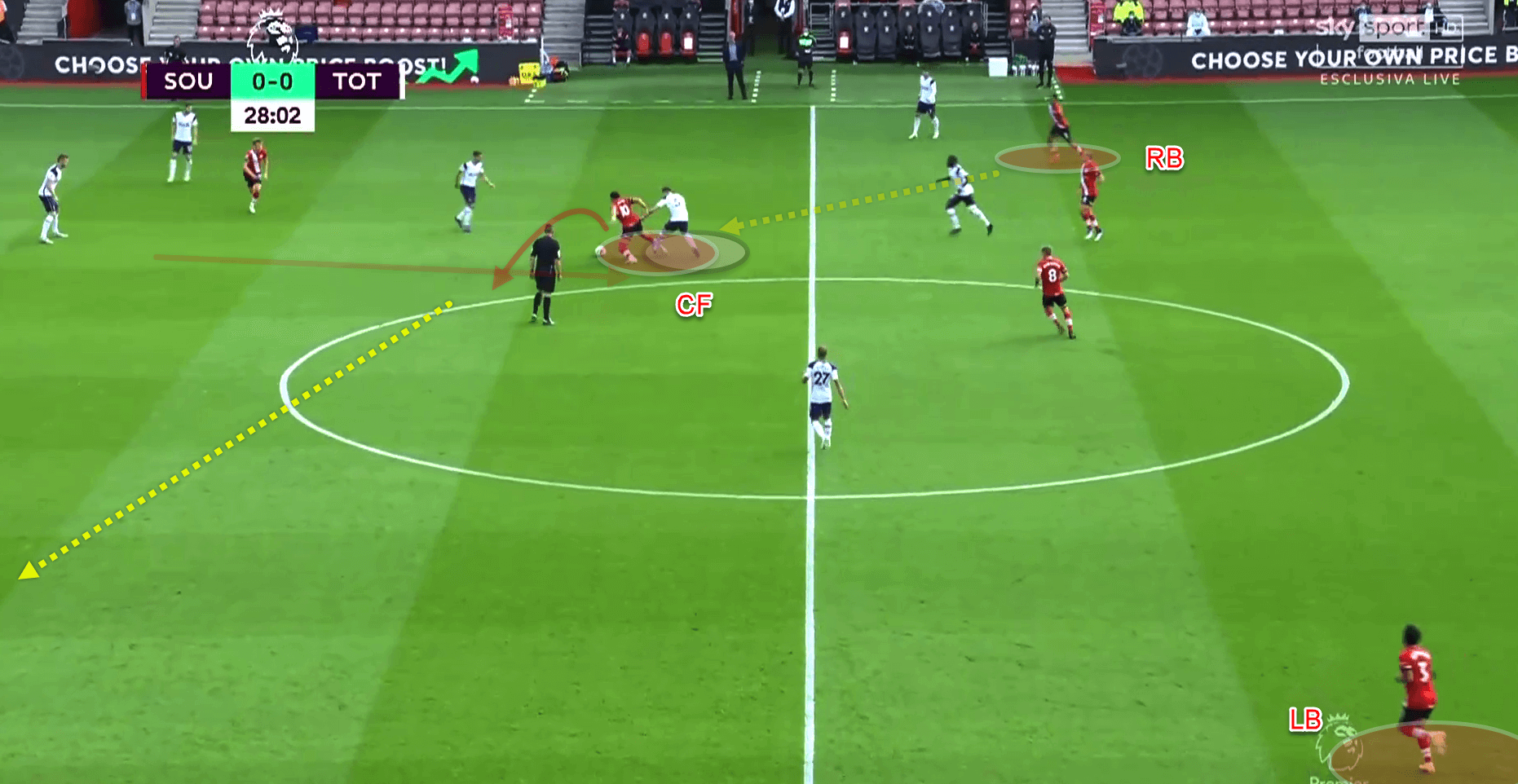
As the right-back takes his first touch forward on his second touch, he then plays a forward pass to mee the run of the ’10’ Adams. Adams does well to roll the Spurs midfielder, The English forward then uses the chance to turn and play a cross-field pass to Tottenham’s weak side.
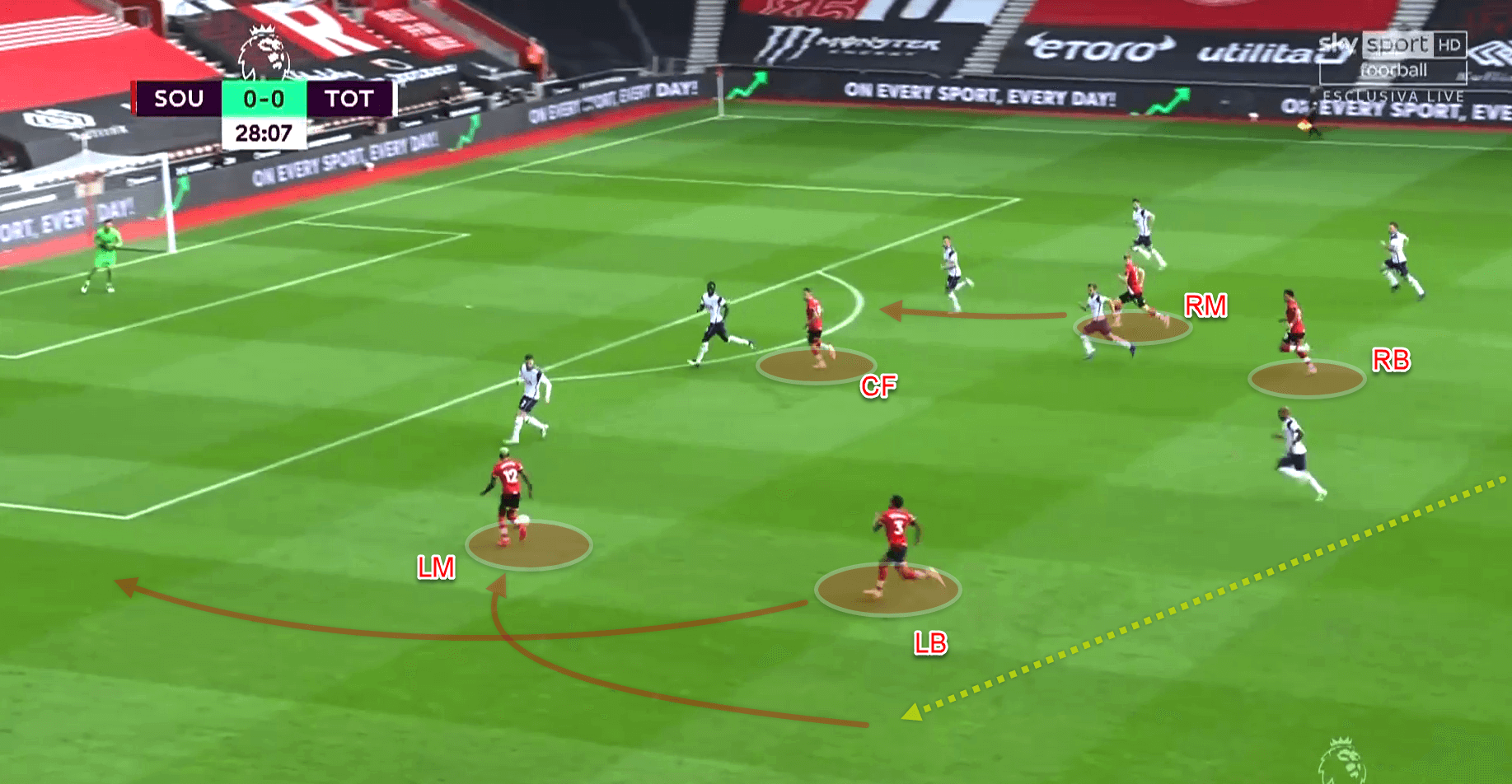
Djénépo receives the pass, notice then how close left-back Bertrand is to support the attack.
So not to occupy the same vertical channel Djénépo drives inside while Bertrand continues on the overlap. Meanwhile, Right midfielder and right-back come central to bolster the attack.
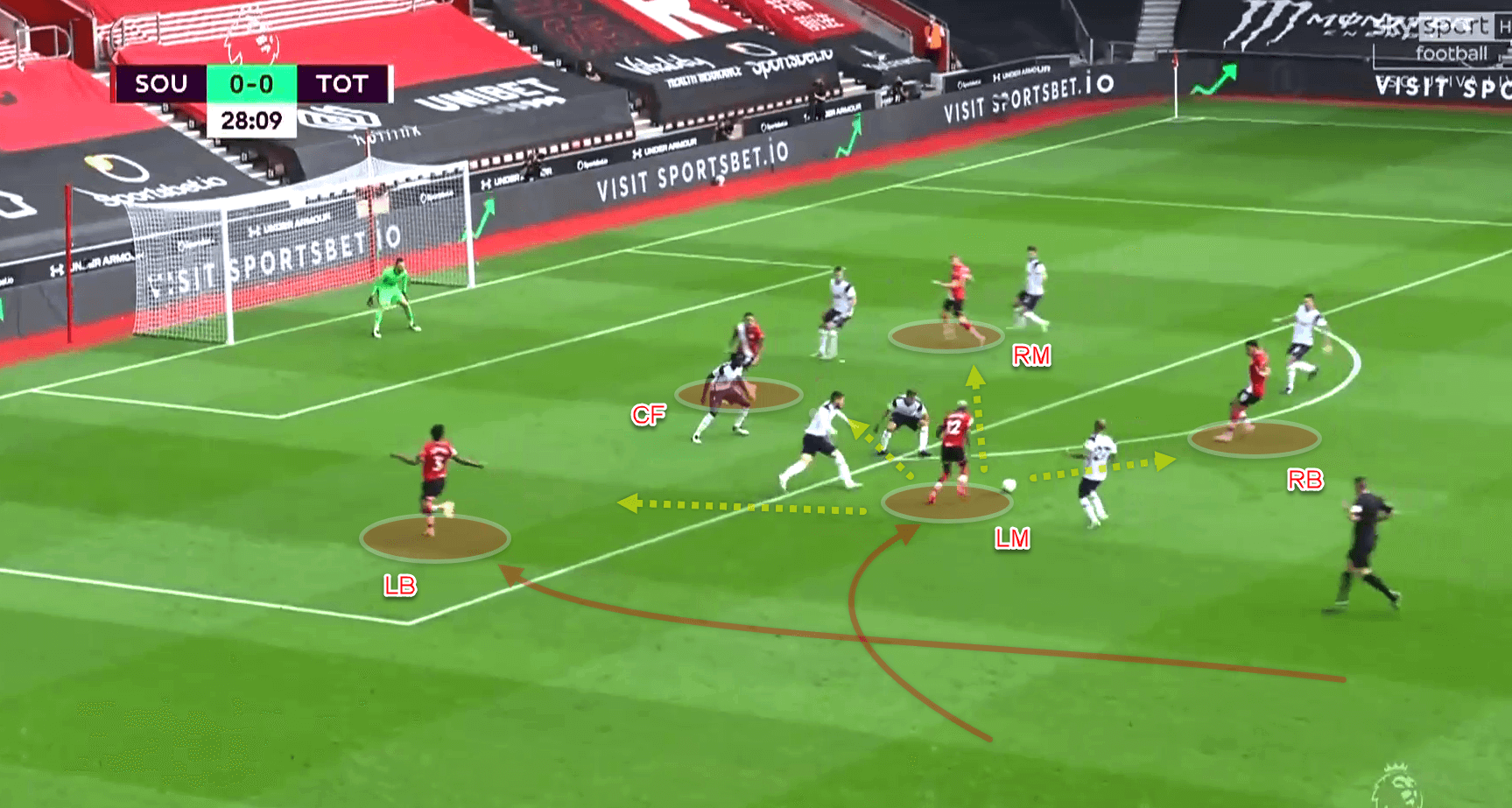
From here, Djénépo reaches a good position to make something happen, notice all available attacking options, Bertrand has made himself a serious threat, should a pass be made to him while Ings and Armstrong make runs to the last defender to offer forward outlets.
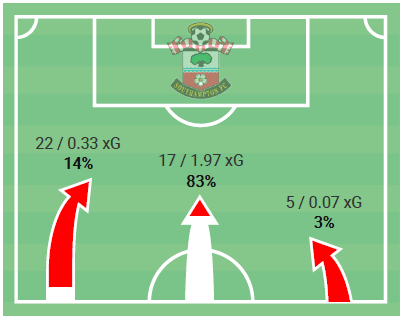
The data above shows us Southampton’s ‘Attacks by Flanks’. Here we can observe The Saints were more dangerous on the side of there inverted winger Djénépo with the support of Bertrand on the left while the more prominent attacks came by way of central attacks.
Conclusion
Six of the seven goals were all scored as a result of a quick transition, beating the defending team to a chance before they could take up a defensive organisation. In the modern game, the chances created by way of a quick transition hold more value than ever before, and this game was an example of that.
Credit to Mourinho, as he knows how to utilise all the attacking potential at his disposal, relative to the qualities of the opposition. His celebration for Spurs third goal exemplifies that, a two-pass combination from the centre-back outside his box, to Kane in the middle, to Son through on goal. A slick, quick, direct attack straight from the training ground.
Although having the superior xG of 2.15 Hasenhüttl will not find much to be happy about in his side’s performance. I’m certain like himself he will hold his players to a higher standard. Having conceded five goals in the manner they did, perhaps we can call this the Leicester City ‘9-0’ of 2020.
Hasenhüttl in many regards has proven himself to be a top-level manager and I for one would be certain this scoreline is not a fair reflection of his abilities as a coach or manager. However, he like his players must take their bitter medicine today, learn from it quickly, thus to avoid another potential relegation scrap in the 2020 /21 Premier League Season.

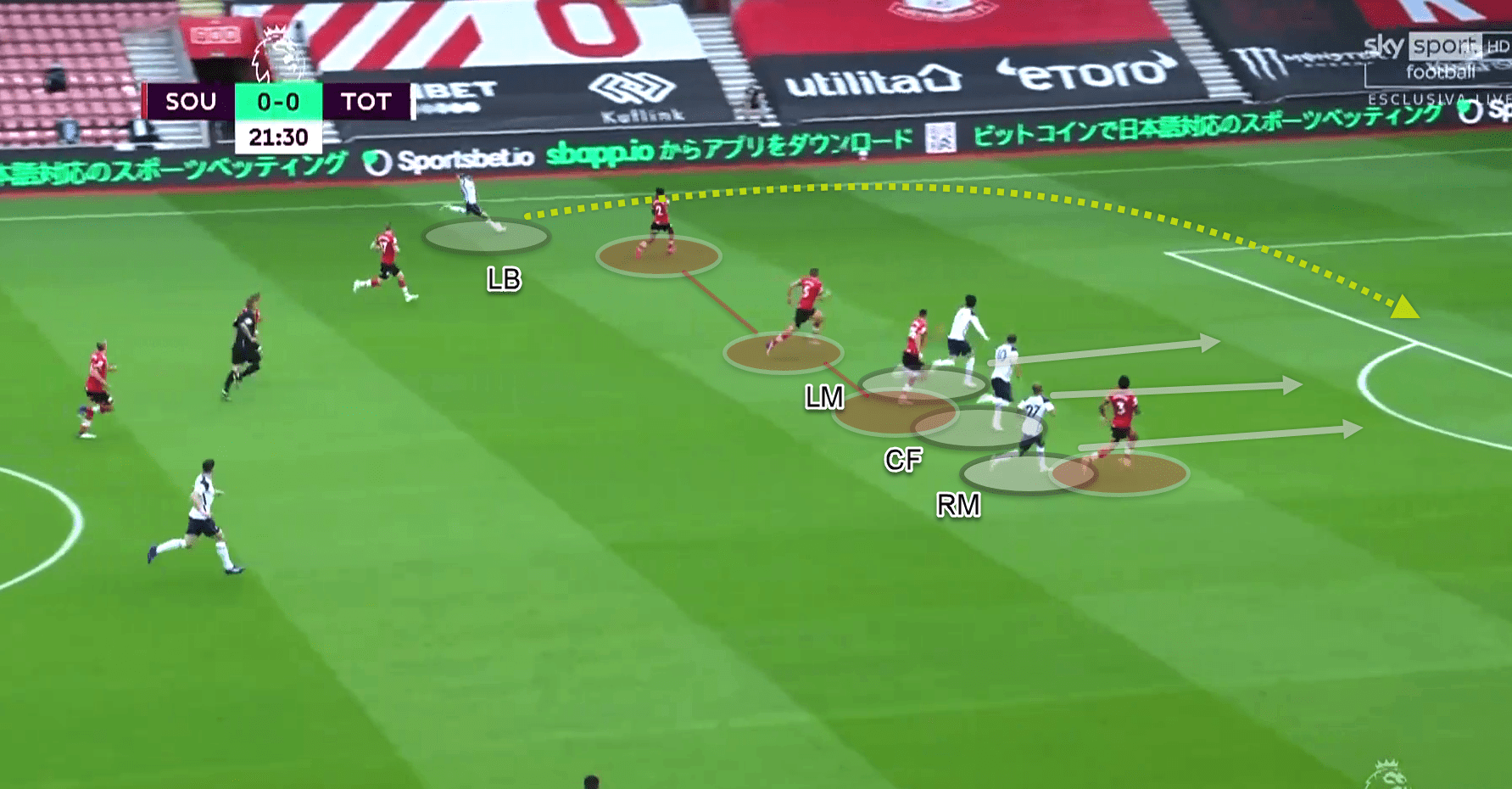


Comments